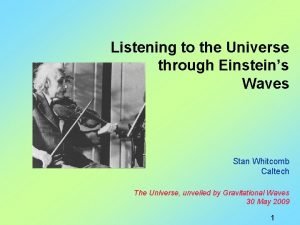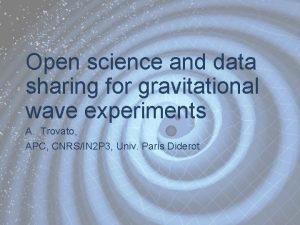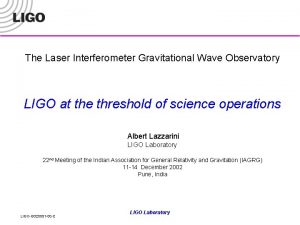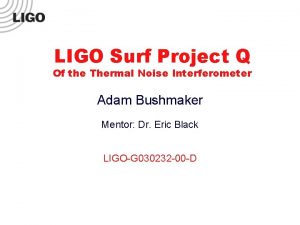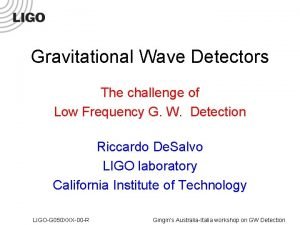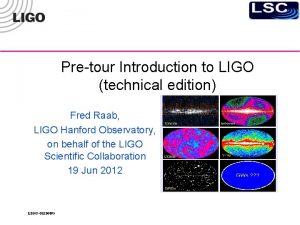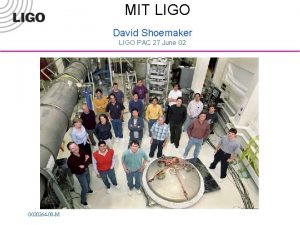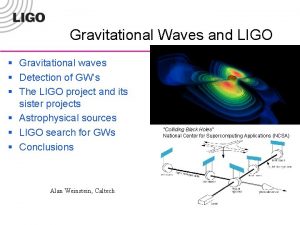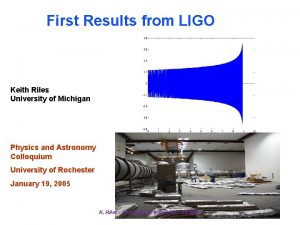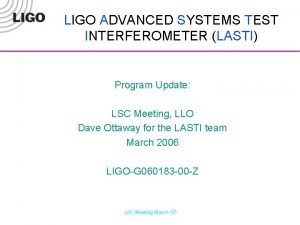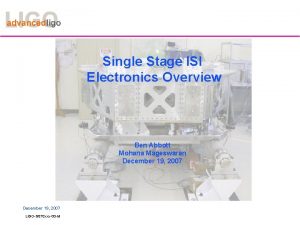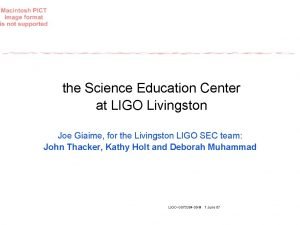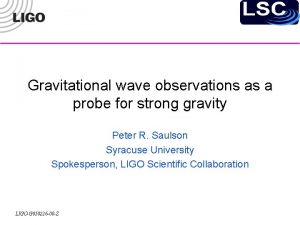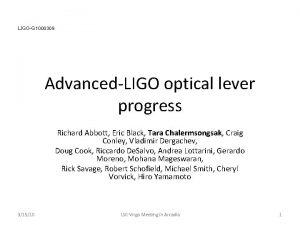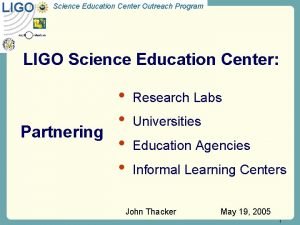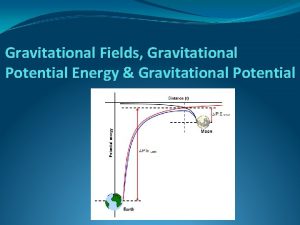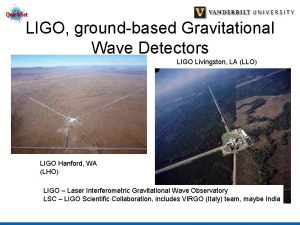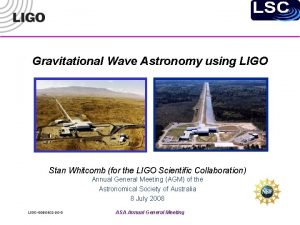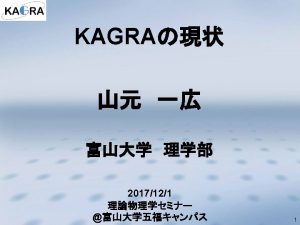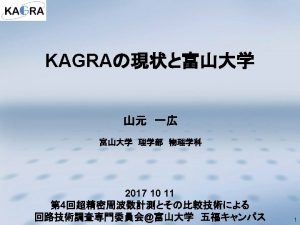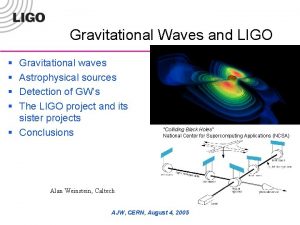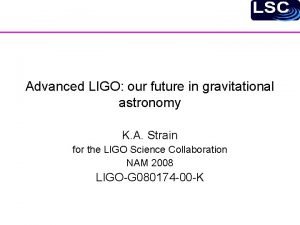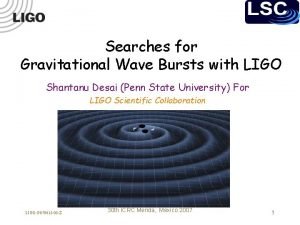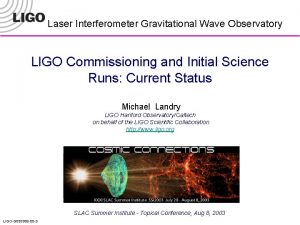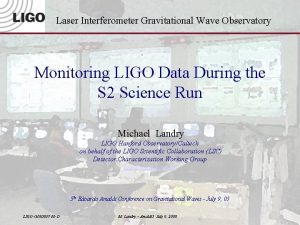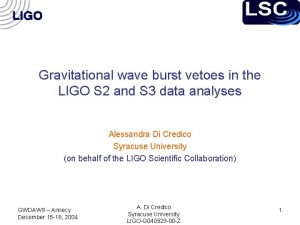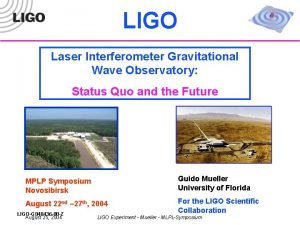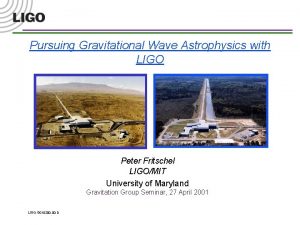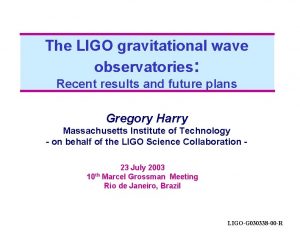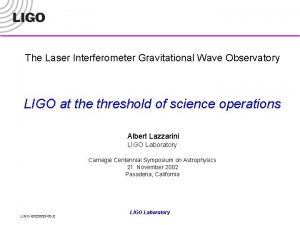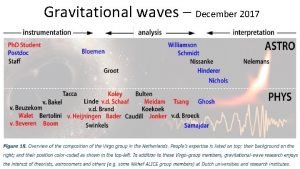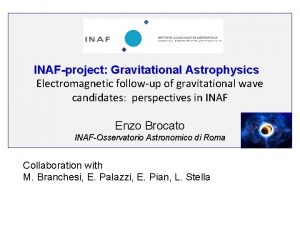LIGO on the threshold of Gravitational Wave Astronomy











































- Slides: 43

LIGO, on the threshold of Gravitational Wave Astronomy Stan Whitcomb (for the LIGO Scientific Collaboration) Seminar at the National Superconducting Cyclotron Lab Michigan State University 14 February 2007 LIGO-G 070022 -00 -D NSCL Seminar

A Series of Questions • • • LIGO-G 070022 -00 -D What is LIGO? Why is LIGO? How does LIGO work? Where is LIGO? When is LIGO? How well does LIGO work? What has LIGO seen? What’s next for LIGO? Who is LIGO? NSCL Seminar 2

What is LIGO? Numb 3 rs “The Running Man” February 3, 2005 • • National facility operated by Caltech and MIT for NSF Cutting edge technology in lasers, optics, quiet mechanical systems, control systems, computational systems, … Tabletop experimental physics on a really BIG scale Rich community of researchers and educators LIGO-G 070022 -00 -D NSCL Seminar 3

Gravitational Wave Physics • • Einstein (in 1916 and 1918) recognized gravitational waves in his theory of General Relativity » Necessary consequence of Special Relativity with its finite speed for information transfer » Most distinctive departure from Newtonian theory Time-dependent distortions of space-time created by the acceleration of masses » Propagate away from the sources at the speed of light » Pure transverse waves » Two orthogonal polarizations LIGO-G 070022 -00 -D NSCL Seminar 4

Why is LIGO? • Physics » Existence of gravitational waves » Dynamics of General Relativity in the strong field regime • Astronomy » Sources of strong gravitational waves hard to study using electromagnetic radiation (weak EM emission, hidden by matter) » Waves carry direct information about the source which is difficult or impossible to get in other ways LIGO-G 070022 -00 -D NSCL Seminar 5

Short Gamma Ray Bursts (GRBs) • • GRBs: long-standing puzzle in astrophysics » Short, intense bursts of gamma rays » Isotropic distribution “Long” GRBs identified with type II (or Ic) supernovae in 1998 “Short” GRBs hypothesized as NS-NS or NS-BH collisions/mergers Inability to identify host galaxies left many questions LIGO-G 070022 -00 -D NSCL Seminar 6

First Identification from SWIFT GRB 050509 b (May 9, 2005) Burst Alert Telescope (BAT) X Ray Telescope (XRT) Gehrels et al. , Nature, 437, 851, 2005 • • • Near edge of large elliptical galaxy (z = 0. 225) Apparent distance from center of galaxy = 35 kpc Strong support for inspiral/merger hypothesis LIGO-G 070022 -00 -D NSCL Seminar 7

Using Gravitational Waves to Learn about Short GRBs Chirp Signal binary inspiral Neutron Star Merger Simulation and Visualization by Maximilian Ruffert & Hans-Thomas Janka LIGO-G 070022 -00 -D Chirp parameters give: • Masses of the two bodies (NS, BH) • Distance from the earth • Orientation of orbit • Beaming of gamma rays (with enough observed systems) NSCL Seminar 8

Another Potential GW Source: Low-Mass X-ray Binaries • • • Binary systems consisting of a compact object (neutron star or blackhole) and a <1 M • companion star (example Sco X-1) Companion over-fills Roche-lobe and material transfers to the compact star (X-ray emission) Angular momentum transfer spins up neutron star Observed Quasi-Periodic Oscillations indicate maximum spin rate for neutron stars Mechanism for radiating angular momentum: gravitational waves? Imagine the Universe NASA High Energy Astrophysics Science Archive LIGO-G 070022 -00 -D NSCL Seminar 9

How does LIGO work? Numb 3 rs “The Running Man” February 3, 2005 • Need to do a bit more than just shoot the beams through a 4 km L-shaped vacuum pipe LIGO-G 070022 -00 -D NSCL Seminar 10

Detecting GWs with Interferometry Suspended mirrors act as “freely-falling” test masses (in horizontal plane) for frequencies f >> fpend Terrestrial detector For h ~ 10– 22 – 10– 21 L ~ 4 km (LIGO) DL ~ 10 -18 m LIGO-G 070022 -00 -D NSCL Seminar 11

Optical Configuration Power Recycled Michelson Interferometer with Fabry-Perot Arm Cavities end test mass (DL) ~ l 4 Sensitivity km Fabry-Perot arm / Number of Bounces in Arm (~100) 100 cavity / Sqrt (Number of photons hitting BS) (1020) “typical” photon makes ~ 10 -18 m 200 x 50 bounces recycling mirror input test mass Laser signal LIGO-G 070022 -00 -D beam splitter NSCL Seminar 12

Test Mass/Mirrors • • Substrates: Si. O 2 » 25 cm Diameter, 10 cm thick » Homogeneity < 5 x 10 -7 » Internal mode Q’s > 2 x 106 Polishing » Surface uniformity < 1 nm rms (l / 1000) » Radii of curvature matched < 3% Coating » Scatter < 50 ppm » Absorption < 0. 5 ppm » Uniformity <10 -3 Production involved 6 companies, NIST, and LIGO-G 070022 -00 -D NSCL Seminar 13

Test Mass Suspension and Control LIGO-G 070022 -00 -D NSCL Seminar 14

How does LIGO work? Initial LIGO Sensitivity Goal • Strain sensitivity <3 x 10 -23 1/Hz 1/2 at 200 Hz Sensing Noise » Photon Shot Noise » Radiation Pressure » Residual Gas Displacement Noise » Seismic motion » Thermal Noise LIGO-G 070022 -00 -D NSCL Seminar 15

Where is LIGO? 4 km + 2 km 4 km LIGO-G 070022 -00 -D NSCL Seminar 16

When is LIGO? Last NSCL Seminar? (~1995) 1999 2000 2001 2002 2003 2004 2005 2006 3 4 1 2 3 4 1 2 3 4 Inauguration First Lock Full Lock all Iinterferometers 4 K strain noise at 150 Hz Engineering 10 -17 10 -18 10 -20 10 -21 E 2 E 3 E 5 E 7 E 8 Science S 1 E 9 S 2 Now 10 -22 E 10 S 3 Strain [Hz-1/2] 3 x 10 -23 E 11 S 4 S 5 Runs First Science Data LIGO-G 070022 -00 -D NSCL Seminar 17

How well does LIGO work? Measures of performance • Spectral sensitivity • Duty factor LIGO-G 070022 -00 -D NSCL Seminar 18

How well does LIGO work? Sensitivity LIGO-G 070022 -00 -D NSCL Seminar 19

How well does LIGO work? Progress toward Design Sensitivity LIGO-G 070022 -00 -D NSCL Seminar 20

“Just” Increase the Laser Power? • • • Importance of angular control of optics » Servo control at low frequencies to maintain alignment Mirror twists Cavity mode moves laterally Poor overlap at beamsplitter increase light out the “dark port” Optical spring (radiation pressure) changes the frequencies of mirror’s angular mode Need adaptive shaping for feedback dependent on power photodiode LIGO-G 070022 -00 -D NSCL Seminar 21

How well does LIGO work? Sensitivity LIGO-G 070022 -00 -D NSCL Seminar 22

How well does LIGO work? Duty Factor LIGO-G 070022 -00 -D NSCL Seminar 23

How well does LIGO work? S 5 so Far LIGO-G 070022 -00 -D NSCL Seminar 24

What has LIGO Seen? LIGO Data Analysis Data analysis by the LIGO Scientific Collaboration (LSC) is organized into four types of analysis: • • • Binary coalescences with modeled waveforms (“inspirals”) Transients sources with unmodeled waveforms (“bursts “) Continuous wave sources (“GW pulsars”) • Stochastic gravitational wave background (cosmological & astrophysical foregrounds) LIGO-G 070022 -00 -D NSCL Seminar 25

Searches for Coalescing Compact Binary Signals in S 5 binary neutron star horizon distance: 25 Mpc Average over run 130 Mpc Image: R. Powell binary black hole horizon distance LIGO-G 070022 -00 -D 3 months of S 5 data analyzed 1 calendar yr in progress Peak at total mass ~ 25 Msun NSCL Seminar 26

• • preliminary S 4 Upper Limit: Compact Binary Coalescence Rate/L 10 vs. binary total mass L 10 = 1010 Lsun, B (1 Milky Way = 1. 7 L 10) Dark region excluded at 90% confidence Preliminary 10 / yr / L 10 1. 4 -1. 4 Mo 0. 1 / yr / L 10 0. 8 -6. 0 Msun LIGO-G 070022 -00 -D

All-Sky Searches for GW Bursts • Goal: detect short, arbitrary GW signals in LIGO frequency band » Stellar core collapse, compact binary merger, etc. — or unexpected sources No matched filtering! Excess signal power and crosscorrelation among data streams from multiple detectors Search for GW bursts in LIGO data • Detection algorithms tuned for 64– 1600 Hz, duration << 1 sec • Veto thresholds pre-established before looking at data • Corresponding energy emission sensitivity EGW ~ 10– 1 Msun at 20 Mpc (153 Hz case) LIGO-G 070022 -00 -D Rate Limit (events/day, 90% C. L. ) • NSCL Seminar S 1 S 2 S 4 First 5 months of S 5 Expected, if no detections hrss (root-sum-squared strain amplitude) 28

preliminary Triggered Searches for GW Bursts Gamma-Ray Bursts LIGO-LHO RXTE/RHESSI LIGO-LLO Swift/ HETE-2/ IPN/ INTEGRAL Soft Gamma Repeater 1806 -20 v v v v galactic neutron star (10 -15 kpc) with intense magnetic field (~1015 G) source of record gamma-ray flare on December 27, 2004 quasi-periodic oscillations found in RHESSI and RXTE x-ray data search LIGO data for GW signal associated with quasi-periodic oscillations no GW signal found sensitivity: EGW ~ 10– 7 to 10– 8 Msun for the 92. 5 Hz QPO this is the same order of magnitude as the EM energy emitted in the flare LIGO-G 070022 -00 -D v v v NSCL Seminar search LIGO data surrounding GRB trigger using crosscorrelation method no GW signal found associated with 39 GRBs in S 2, S 3, S 4 runs set limits on GW signal amplitude 53 GRB triggers for the first five months of LIGO S 5 run typical S 5 sensitivity at 250 Hz: EGW ~ 0. 3 Msun at 20 Mpc 29

Search for Known Pulsars preliminary Joint 95% upper limits for 97 pulsars using ~10 months of the LIGO S 5 run. Results are overlaid on the estimated median sensitivity of this search. For 32 of the pulsars we give the expected sensitivity upper limit (red stars) due to uncertainties in the pulsar parameters Pulsar timings provided by the Jodrell Bank pulsar group Lowest GW strain upper limit: PSR J 1802 -2124 (fgw = 158. 1 Hz, r = 3. 3 kpc) h 0 < 4. 9× 10 -26 ry a n i m Preli Lowest ellipticity upper limit: PSR J 2124 -3358 (fgw = 405. 6 Hz, r = 0. 25 kpc) < 1. 1× 10 -7 LIGO-G 070022 -00 -D NSCL Seminar 30

LIGO Limits on Isotropic Stochastic GW Signal • Cross-correlate signals between 2 interferometers • LIGO S 1: ΩGW < 44 H 0 = 72 km/s/Mpc PRD 69 122004 (2004) • LIGO S 3: ΩGW < 8. 4 x 10 -4 PRL 95 221101 (2005) • LIGO S 4: ΩGW < 6. 5 x 10 -5 (new upper limit; accepted for Ap. J) • Initial LIGO, 1 yr data • • Bandwidth: 51 -150 Hz; Expected sensitivity ~ 4 x 10 -6 Upper limit from Big Bang nucleosynthesis 10 -5 Advanced LIGO, 1 yr data Expected Sensitivity ~1 x 10 -9 GWs neutrinos photons now LIGO-G 070022 -00 -D NSCL Seminar 31

Stochastic Sources including Big Bang: Predictions and Limits 0 Log ( ) -2 -4 BB Nucleosynthesis Pulsar Cosmic strings Timing Expected, end of S 5 -6 -8 -10 CMB 1 year Advanced LIGO Pre-big bang model -12 Inflation EW or SUSY Phase transition -14 Slow-roll Cyclic model -18 -16 -14 -12 -10 -8 LIGO-G 070022 -00 -D -6 -4 -2 Log (f [Hz]) NSCL Seminar 0 2 4 6 8 10 32

What’s next for LIGO? More S 5 Results? • APS meeting, Jacksonville, April 14 -17, 2007 LIGO-G 070022 -00 -D NSCL Seminar 33

What is next for LIGO? A Global Network of GW Detectors LIGO GEO Virgo TAMA/LCGT • Detection confidence • Locate sources • Decompose the polarization of gravitational waves AIGO LIGO-G 070022 -00 -D NSCL Seminar 34

What’s next for LIGO? A Global Network of GW Detectors Virgo Italy GEO TAMA VIRGO GEO 600 Germany LIGO Hanford LIGO Livingston = c t d L D q 1 2 LIGO-G 070022 -00 -D NSCL Seminar 35

What’s next for LIGO? Advanced LIGO • Take advantage of new technologies and on-going R&D » » Active anti-seismic system operating to lower frequencies Lower thermal noise suspensions and optics Higher laser power More sensitive and more flexible optical configuration x 10 better amplitude sensitivity x 1000 rate=(reach)3 1 day of Advanced LIGO » 1 year of Initial LIGO ! Planned for FY 2008 start, installation beginning 2011 LIGO-G 070022 -00 -D NSCL Seminar 36

What’s next for LIGO? Targets for Advanced LIGO • • Neutron star & black hole binaries » inspiral » merger Spinning neutron stars » LMXBs » known pulsars » previously unknown Supernovae Stochastic background » Cosmological » Early universe LIGO-G 070022 -00 -D NSCL Seminar 37

Anatomy of the Projected Adv LIGO Detector Performance • Suspension thermal noise • Internal thermal noise Initial LIGO 10 -22 • • Newtonian background, estimate for LIGO sites 10 -23 Seismic ‘cutoff’ at 10 Hz 10 -24 • Quantum noise (shot noise + radiation pressure noise) -25 10 dominates at 1 Hz most frequencies LIGO-G 070022 -00 -D NSCL Seminar 10 Hz 100 Hz 1 k. Hz 38

What’s next for LIGO? Beyond Advanced LIGO • • Third generation GW interferometers will have to confront (and beat) the uncertainty principle Standard Quantum Limit (early 1980’s) » » • Manifestation of the “Heisenberg microscope” Shot noise ~ P-1/2 Radiation pressure noise ~ P 1/2 Together define an optimal power and a maximum sensitivity for a “conventional” interferometer Resurgent effort around the world to develop sub-SQL measurements (“quantum non-demolition”) » Require non-classical states of light, special interferometer configurations, … • Cryogenic? Underground? LIGO-G 070022 -00 -D NSCL Seminar 39

Who is LIGO? • LIGO Laboratory » Four sites (Caltech, MIT, LIGO Hanford, LIGO Livingston) » ~180 scientists, students, engineers, other staff • LIGO Scientific Collaboration » Over 500 members » Over 40 universities or research centers » Eight countries LIGO-G 070022 -00 -D NSCL Seminar 40

Who is LIGO? The LIGO Scientific Collaboration LIGO-G 070022 -00 -D NSCL Seminar 41

Who is LIGO? Education motivated by Research • • Outreach to communities, schools, based at two LIGO sites 1/3 of all people at sites are visitors! LIGO-G 070022 -00 -D NSCL Seminar 42

Final Thoughts • • • We are on the threshold of a new era in GW detection » LIGO has reached design sensitivity and is taking data » First detections could come in the next year (or two, or three …) A worldwide network is starting to come on line » Groundwork has been laid for operation as a integrated system Second generation detector (Advanced LIGO) is approved and ready to start fabrication » Will expand the “Science” (astrophysics) by factor of 1000 LIGO-G 070022 -00 -D NSCL Seminar 43
 Learning astronomy by doing astronomy
Learning astronomy by doing astronomy Learning astronomy by doing astronomy
Learning astronomy by doing astronomy Learning astronomy by doing astronomy
Learning astronomy by doing astronomy Giant wave murmurs across universe
Giant wave murmurs across universe Gravitational wave open science center
Gravitational wave open science center Gravitational wave hear murmurs universe
Gravitational wave hear murmurs universe Gravitational wave
Gravitational wave Gravitational wave
Gravitational wave Ligo surf
Ligo surf Ligo challenge xxx
Ligo challenge xxx Ligo
Ligo David shoemaker ligo
David shoemaker ligo Ligo
Ligo Hanford
Hanford Ligo
Ligo Where was ben abbott born
Where was ben abbott born Ligo science education center
Ligo science education center Ligo
Ligo Ligogram
Ligogram Ligo science education center
Ligo science education center Centre tap rectifier
Centre tap rectifier The wave chapter 10
The wave chapter 10 Difference between full wave and half wave rectifier
Difference between full wave and half wave rectifier Mechanical and electromagnetic waves venn diagram
Mechanical and electromagnetic waves venn diagram Determining the arrival times between p-wave and s-wave
Determining the arrival times between p-wave and s-wave Characteristics of mechanical waves
Characteristics of mechanical waves Transverse and longitudnal waves
Transverse and longitudnal waves Full wave rectified sine wave fourier series
Full wave rectified sine wave fourier series Sound waves are longitudinal waves true or false
Sound waves are longitudinal waves true or false 20 v
20 v Transverse wave and longitudinal wave example
Transverse wave and longitudinal wave example Longitudinal wave
Longitudinal wave Short wave vs long wave radiation
Short wave vs long wave radiation Fourier series periodic function examples
Fourier series periodic function examples Thế nào là mạng điện lắp đặt kiểu nổi
Thế nào là mạng điện lắp đặt kiểu nổi Hình ảnh bộ gõ cơ thể búng tay
Hình ảnh bộ gõ cơ thể búng tay Sự nuôi và dạy con của hươu
Sự nuôi và dạy con của hươu Dạng đột biến một nhiễm là
Dạng đột biến một nhiễm là Nguyên nhân của sự mỏi cơ sinh 8
Nguyên nhân của sự mỏi cơ sinh 8 Phản ứng thế ankan
Phản ứng thế ankan Gấu đi như thế nào
Gấu đi như thế nào Thiếu nhi thế giới liên hoan
Thiếu nhi thế giới liên hoan điện thế nghỉ
điện thế nghỉ Vẽ hình chiếu vuông góc của vật thể sau
Vẽ hình chiếu vuông góc của vật thể sau



